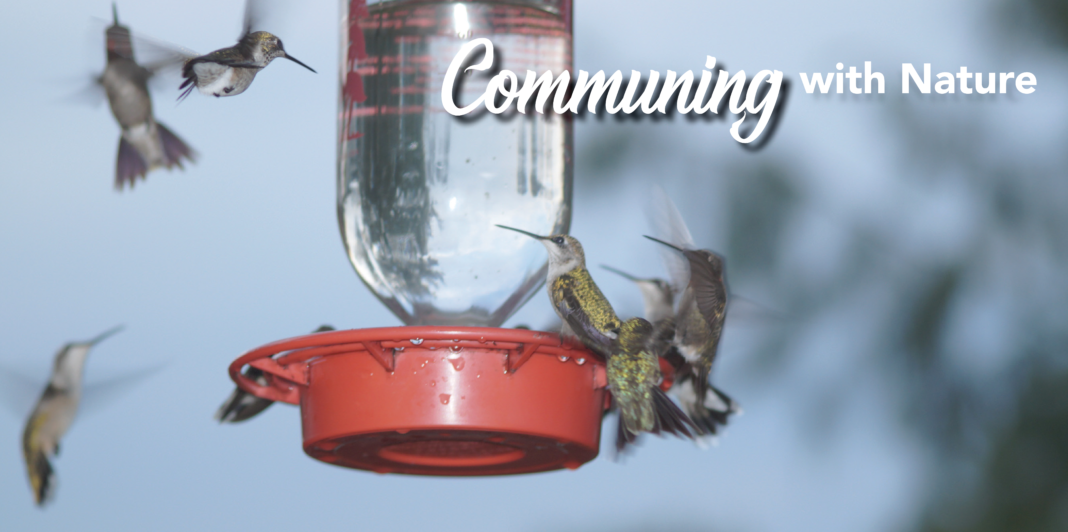Severe Heat Poses Many Challenges for Hummingbirds in Texas
They’re Here! You’ve likely seen a few, or more, Ruby Throated hummingbirds flitting between your native flowers since early August. And if you think the heat is bothering us, it is having a desperate effect on small and delicate hummers.
They need to maintain a constant body temperature of around 104°F. So, with temperatures hitting near that mark daily, they are certainly feeling the effects of dehydration, exhaustion, and stress. It is likely taking a toll on their nesting.
If you’re lucky, you may spot a male Ruby Throated in a courtship display, flying back and forth in a wide arc in front of a female perched in the shade. Many nest in southeast Texas, so look up 10 to 30 feet in leafy trees or large shrubs to find the compact, cup-size nest of grasses, plant fibers, spider webs, and lined with plant down. Hummers camouflage the nests with lichens and dead leaves, so look closely and hope the heat doesn’t hard boil their eggs.
Hummingbirds, mostly Ruby Throated and a few Black-Chinned, migrate through our area for heavy feeding before they cross the Gulf of Mexico for their wintering spots in Mexico and Central America. While most of you recognize the Ruby-Throated, you may have seen Black Chinned birds and not realized it. They are visually similar, especially the females and juveniles of each breed. The big difference is the deep red gorget (coloring on the gorget/throat) of Ruby Throated is royal purple on Black Chinned birds.
Feeding is critical to hummingbirds as they prepare for non-stop migration. Many plants are wilted and shriveled and making it hard to keep birdbaths or water sources full and fresh. To fight the heat, place feeders in shade to keep them a bit cooler and refill daily to hinder algae growth. Moving birdbaths into the shade will keep it from boiling, and refill often.
Most hummers guard their chosen feeder by sitting on a nearby branch and diving at any intruders. This year, we see them spending more time on shady branches, and acting more competitively than usual at the feeders with less flowers to visit.
Severe heat can pose many challenges for hummingbirds in Texas. However, there are some things that we can do to help them survive and thrive in hot weather.
Provide clean, fresh sugar water (one part sugar to 4 parts water brought to a boil and cooled, WITH NO RED DYE). Mix one or two gallons and keep it refrigerated, they seem to like it chilled!
Offer plenty of extra water: Birdbaths, fountains, misters, or sprinklers to help them keep cool.
Avoid using pesticides or herbicides that can harm hummingbirds and other pollinators and their food sources.
Red attracts! Select feeders with red elements, include red, tubular flowers in your garden (salvia, hamelia-hummingbird bush, hibiscus, shrimp plants are some of my favorites).
While patience is usually the key to drawing hummingbirds to your garden, this year the critical element is helping them survive. Fresh food, clean water, and shady spaces are critical. While we all want the cool breezes of fall to come soon, the first real cool front to chase them on to their winter homes. Let’s keep them here for a while, with fresh food, clean water, and shady spaces.
Learn more about hummingbirds and other wildlife by joining a chapter of the Texas Master Naturalist or Texas Master Gardeners. Piney Wood Lakes Master Naturalist serves Polk, San Jacinto, Trinity, and Tyler Counties with volunteer opportunities, educational resources, and conservation projects. txmn.org/pineywoodlakes. SJC Master Gardeners serves San Jacinto and Polk Counties, sharing time, knowledge, and expertise to improve the quality of life. txmg.org/sjmg.















